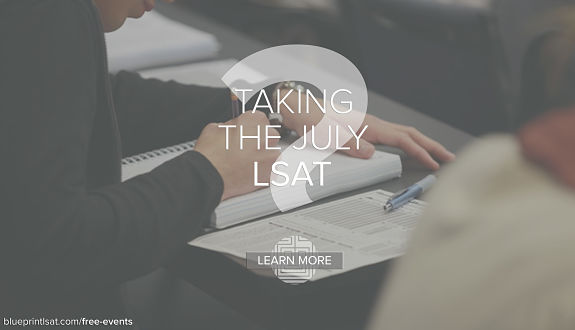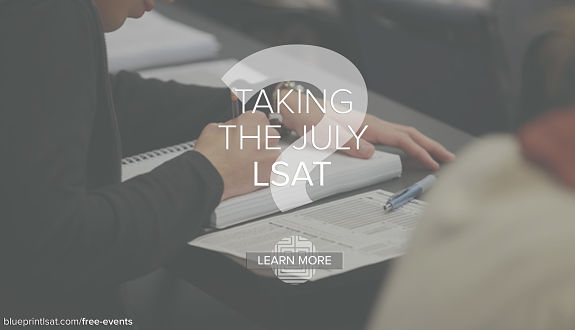Five Important Facts About the July LSAT
- by
- Apr 26, 2018
- Blueprint Products and Promotions, LSAT
- Reviewed by: Matt Riley


Are you planning on taking the July LSAT, but missed our webinar last night? The one that was entitled “Everything You Need to Know About the July LSAT,” in which we provided attendees a primer on everything they need to know about the July LSAT? You did? Shame on you! Well … actually we can find it in our hearts to forgive you. We heard the basketballs were played very well last night. LeBron James and Russell Westbrook: very good at basketball, who knew? After last night, you know, we presume.
But you don’t know about the July LSAT. You missed out. But that’s OK. Today, we’ll give you five important facts to remember about the July LSAT.
1. It’s given on a Monday, in the afternoon
First up, some good news!The July LSAT will be given on a Monday — Monday, July 23rd, specifically — and check-in time is at 12:30 in the afternoon. That’s different from every other LSAT except the June test, which are all given on a Saturday at the unconscionably early hour of 8:30 am. So if you’re a night owl or a morning grumpster or, you know, an incorrigible alcoholic who can’t peel yourself out of bed before noon, well, congratulations, you picked the right exam!
2. It’s nondisclosed [sic]
Next up is less good news, sort of. It’s really not a big deal, but you should know anyway. The July exam is going to be “nondisclosed.” Which is not a real word, but it’s still a word that the makers of this exam insist on using.
What’s a “nondisclosed” exam? Well, when you take any LSAT other than the February (and now July) LSAT, you get your score, plus a bunch of other stuff. You’ll get a copy of your answer sheet, a copy of your exam, you’ll be able to see the score distribution that shows how the raw scores translated to scaled scores. Well, on “nondisclosed” exams, like the February and now the July exam, you only get your score back. Nothing else.
It’s not a big deal, especially if you only plan on taking the exam once. In fact, most people who get that stuff back don’t bother looking at any of it. Really, only prep test companies like Blueprint and nerds like me who care about this test way too much put much value in those extra materials.
The only way a test being nondisclosed would affect you is if you plan on retaking the exam. In that case, it would be helpful to see how you did on the actual exam, to guide your studies for the next exam. But even if you take a nondisclosed test and decided you want to take a later exam, you’l be fine. You’ll have taken so many practice exams before the real test. Those will provide a much larger data set than just one exam, and they’ll be just as, if not more, reliable in helping you plan your studies for the next exam.
Why do they make tests nondisclosed? Well the short answer is that they sometimes need to administer make-up tests. And they use questions from nondisclosed tests for make-up tests. For instance, last year, Hurricane Irma closed many test centers in Florida for the September LSAT. They administered make-up tests to those students a few weeks later, using exams made up of questions from previously nondisclosed exams.
3a. Scheduling a retake might be a little hairy
Before the July exam — an era which has a crass and unprintable abbreviation — when the LSAT was just given in February, June, September, and December, you had a lot of time to figure out if you wanted to take the exam again. If you took the exam in June, you could wait three weeks to get your score back, see how you did, and then decide, if you weren’t happy with your score, if you wanted to take the September exam.
Now that we have June, July, and September in semi-quick succession, you no longer have that luxury. So if you take the July 23rd exam, you don’t have a lot of time to figure out if you should take it again. We won’t know when exactly the deadline to sign up for the September 8th LSAT is until registration for that test opens in May, but the deadline is traditionally five or six weeks before the exam. And that means the sign-up will probably be in late July or early August. Which means that if you take the July exam and decide that you want to take the September exam, you won’t have much time to do so. You’ll almost certainly have to make this decision before you get your July score back. So what should you do? You have a few options.
One, you could sign up for the September test before or just after the July test, just to be safe. If you get your July score back and it’s good news and you decide you don’t need to take the September test, you can withdraw from the September test for a partial refund. It costs $180 to sign up for the LSAT, and if you withdraw before the partial refund deadline passes, you’ll get $50 back. So this option could cost you $130, if you decide you don’t need to take September.
Alternatively, you could just wait to get your score back, and then sign up for the November 17th exam instead of the September exam. You’ll have to dedicate more of your year to studying for the LSAT, but you’ll also have more time to get super prepared for the November test. If you go this route, however, it’s important that you get all your other application materials together as you study for the November test. You’ll want to make your November LSAT score the last thing you’re waiting on before submitting your applications.
Finally, you could just play it by ear. Just see how the July exam goes, and make your decision based on that. After taking a lot of practice exams before the July exam, you should develop a fairly reliable feeling about how the exam went for you. Now, this isn’t always the case — I’ve had many neurotic students far exceed their impressions on how they did. But if you can give a realistic appraisal of your performance, use that to determine if you should sign up for the September test.
3b. But, good news, if you use your July LSAT score, you’ll be able to apply early
OK, even though rescheduling might be a little dicy, if you’re able to use your July score, you’ll can apply very early in the 2018-19 application cycle. Law schools use rolling admissions — they start giving away seats as soon as they start receiving applications. Law schools start accepting applications in August, September, and October. Which means that, if you take the July exam, you have some time to get your application materials together after the exam, and send your applications in very early the application cycle. If you can get your applications in before any of the September test takers do, you’ll be like Michael B. Jordan in Black Panther … in super good shape.
And applying early and with a good LSAT score will be in all likelihood especially important next year. The 2017-18 application cycle saw a pretty sizable increase law school applicants and applications for the first time in years. There were more applicants, applying to more places, which makes things more competitive overall. Plus, there was a disproportionate increase in the number of applicants with a score of 165 or above. There was a 28% increase in applicants with a score between 165 and 169; a 15.7% increase in applicants with score between 170 and 174, and a whopping 68.7% increase in applicants with a score over 175.
Plus, there’s evidence that a lot of these applicants are applying early: if you look at the data for the 2017-18 application cycle at November, these increases are even more pronounced. At that point, there was a 36.4% increase for applicants with a score between 165 and 169, a 16.6% increase for applicants with a score between 170 and 174, and an insane 86.6% for applicants with a score over 175. We expect this trend to continue to next year. That suggests that not only will there be more applicants with good scores, but also that a lot of them will be applying early. Ergo, you should apply as well. Which you can do, with the July exam.
4. Otherwise, it’s going to be a pretty typical LSAT
Other than that, we expect the July LSAT to be fairly typical. The makers of the LSAT take great care to “equate” each LSAT, to ensure that, for example, a 160 on one LSAT administration means the same thing as a 160 on a different LSAT administration. They do their best to make sure that each LSAT administration is the same, more or less. So don’t expect the new July LSAT to be any easier or more difficult than any past LSAT.
5. We have courses for the July LSAT, that’ll help you get prepared
One really good way — we might say best way, but we can admit our biases — to study for the July LSAT: take one of Blueprint’s classroom courses! We have many classes starting up for the July LSAT, listed below. These classes are led by the best LSAT instructors in the biz, and students average an 11-point increase from their first to best practice exam. You can even still join some of the courses that have already started; if your local class is already underway, get in contact with the fine folks at the Blueprint office and they’ll help you sort out the logistics.
If there isn’t a July class around you, you can get excellent guidance from Blueprint’s online course. The online course goes through the exact same curriculum as the classroom course, only the disembodied heads of Blueprint founders Matt and Trent will teach you through state-of-the-art online videos. You can supplement either with some one-on-one tutoring, and, between you and me, we’re going to have tutoring sale next week.
Check out the classroom courses below, and good luck on the July LSAT!
Bay Area:
–Berkeley: Started Saturday, 4/21 with instructor Aaron Cohn
Illinois:
–Chicago: Starts Saturday, 5/12 with instructor Cory O’Brien
Los Angeles:
–UCLA: Started Saturday, 4/21 with instructor Kyle Gehrmann
New York:
–Upper East Side 1: Started Saturday, 4/7 with instructor Dash Kwiatkowski
–Upper East Side 2: Starts Sunday, 5/20 with instructor Dash Kwiatkowski
Orange County:
–Irvine: Starts Saturday, 5/5 with instructor Ross Rinehart
District of Columbia:
–Washington, D.C.: Starts Saturday, 5/5 with instructor Shir Davidovicz
Search the Blog

Free LSAT Practice Account
Sign up for a free Blueprint LSAT account and get access to a free trial of the Self-Paced Course and a free practice LSAT with a detailed score report, mind-blowing analytics, and explanatory videos.
Learn More
Popular Posts
-
logic games Game Over: LSAC Says Farewell to Logic Games
-
General LSAT Advice How to Get a 180 on the LSAT
-
Entertainment Revisiting Elle's LSAT Journey from Legally Blonde








